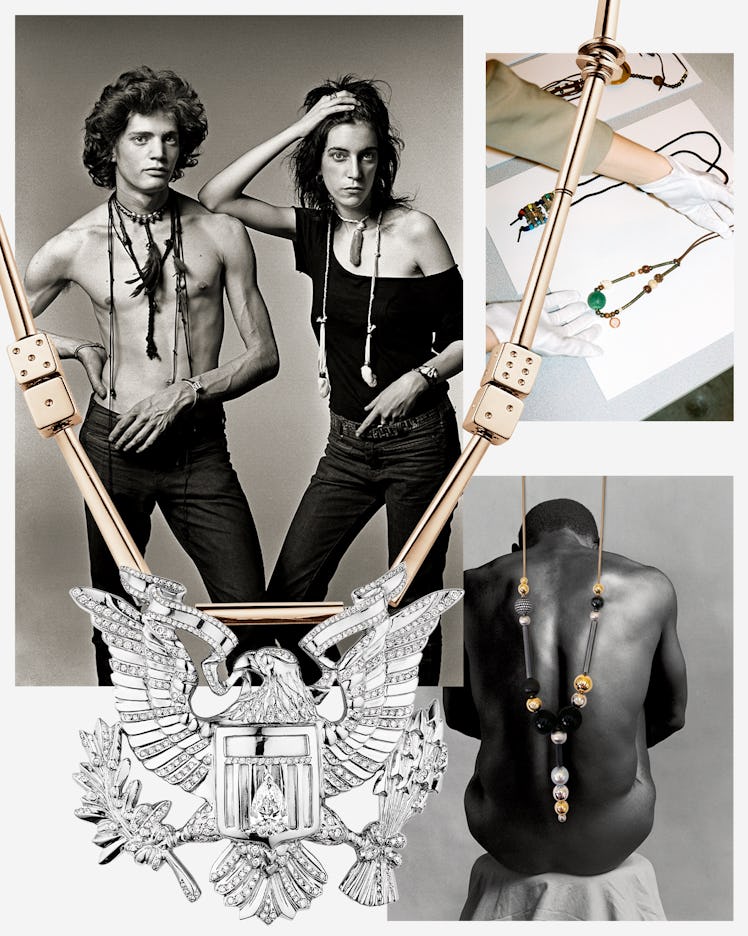A Tribute to Robert Mapplethorpe in Fine Jewelry
The legendary photographer’s handmade creations inspire the latest collection from Repossi.

As one of the great studio photographers of the 20th century, Robert Mapplethorpe has had his storied life played out ad nauseum. And yet, despite Mapplethorpe’s notoriety, his jewelry designs—an important part of his creative output that predates his photography—remain criminally overlooked.
“He was fascinated with adornment, especially jewelry, which he made from an early age,” says Michael Stout, Mapplethorpe’s former lawyer and the president of the Robert Mapplethorpe Foundation. “And he was always very interested in expanding his artistic imprint into the world of fashion.”
Repossi’s new Americana Eagle necklace.
Robert Mapplethorpe in 1971.
Mapplethorpe, who died of AIDS in 1989, may finally be getting his wish. Next month, at the behest of the foundation, Gaia Repossi, the creative director of the eponymous third-generation company, unveils 10 new high jewelry pieces inspired by Mapplethorpe’s originals from the early 1970s. (The first capsule collection in the two-pronged offering was released last year.) “They were perfect,” says Repossi of the baubles Mapplethorpe used to make for friends and acquaintances, including Halston, Marisa Berenson, and Yves Saint Laurent (who Mapplethorpe claimed ripped off his dice jewels and domino cuffs). “But I really wanted to elevate them using fine materials.”
While Mapplethorpe’s long chains and fetish necklaces were made from found objects such as skulls, rabbits’ feet, beads, feathers, and even the occasional shellfish, Repossi’s updates are rendered in exquisite golds and diamonds, and range in price from $2,050 for a ring to $197,000 for an Americana Eagle necklace. “It’s impossible to collaborate with someone who isn’t here,” Repossi explains, “so I was really careful not to violate his vision.”
Her solicitousness has already won the admiration of influential fans. “She has really captured the essence and spirit of his designs,” says Frances Terpak, senior curator and head of photographs at the Getty Research Institute and a coauthor of Robert Mapplethorpe: The Archive, a book that pays special attention to the artist’s early Polaroids, sculpture, and jewelry. “There is a collector bias in favor of his black and white photographs, and the Repossi collaboration will go a long way to redressing that.”
Gaia Repossi examines some of Mapplethorpe’s original creations.
Repossi’s Relic necklace, inspired by one of Mapplethorpe’s pieces, with his 1981 photograph Ajitto.
No one would have been more pleased than Mapplethorpe himself. “He would absolutely have loved the Repossi collection,” Stout says. “As he became more affluent, the level of the jewelry that he acquired for himself increased. He certainly wasn’t going to Harry Winston, but he was no longer just into the cheap beads, nuts, and skulls.”
There will be no shortage of Mapplethorpe-related events to which to wear the pieces. Triptych (Eyes of One on Another), a stage musical composed by Bryce Dessner about the life and photography of Mapplethorpe, is slated for an extensive international tour, following a U.S. run that was cut short by Covid; Hadrian, an opera composed by Rufus Wainwright, is being reprised in Madrid and Barcelona this summer, featuring Mapplethorpe artworks as part of the set design. And this July in London, Alison Jacques, the U.K. gallery that has represented Mapplethorpe since 1999, will have a show of his works, including jewelry, curated by the fashion designer Jonathan Anderson.
“Robert sought ultimate perfection and exquisite beauty, often in controversial subject matter that was far from the art world, with all its polished or seemingly sophisticated inhabitants,” Jacques says. “It was this bridging of opposing, often conflicting worlds that made him the iconic artist that he is and will be for many generations to come.”
Mapplethorpe and Patti Smith, wearing his jewelry designs, in 1969.